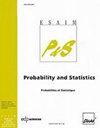含刚性松弛项的非定常可压缩两相流模型的两种计算方法
IF 0.7
4区 数学
Q4 STATISTICS & PROBABILITY
引用次数: 1
摘要
本文采用Baer-Nunziato型模型对两相流进行了数值模拟。这里的重点是涉及三个(或四个)松弛时间尺度的源项的数值处理。将一种基于连续分析ode系统的新的耦合方法与基于分数阶方法的更广泛使用的策略进行了比较。在这两种情况下给出了格式的性质。数值计算表明,从稳定性和精度两方面考虑,应优先采用耦合方法。本文章由计算机程序翻译,如有差异,请以英文原文为准。
Two approaches to compute unsteady compressible two-phase flow models with stiff relaxation terms
The paper deals with the numerical modeling of two-phase flows while using Baer-Nunziato type models. Focus is given here on the numerical treatment of source terms that involve three (or four) relaxation time scales. A new coupled approach relying on the continuous analysis of the system of ODEs is compared with a more widely used strategy grounded on the fractional step approach. Properties of schemes are given in both cases. Several numerical applications show that the coupled approach should be prefered for both stability and accuracy reasons.
求助全文
通过发布文献求助,成功后即可免费获取论文全文。
去求助
来源期刊

Esaim-Probability and Statistics
STATISTICS & PROBABILITY-
CiteScore
1.00
自引率
0.00%
发文量
14
审稿时长
>12 weeks
期刊介绍:
The journal publishes original research and survey papers in the area of Probability and Statistics. It covers theoretical and practical aspects, in any field of these domains.
Of particular interest are methodological developments with application in other scientific areas, for example Biology and Genetics, Information Theory, Finance, Bioinformatics, Random structures and Random graphs, Econometrics, Physics.
Long papers are very welcome.
Indeed, we intend to develop the journal in the direction of applications and to open it to various fields where random mathematical modelling is important. In particular we will call (survey) papers in these areas, in order to make the random community aware of important problems of both theoretical and practical interest. We all know that many recent fascinating developments in Probability and Statistics are coming from "the outside" and we think that ESAIM: P&S should be a good entry point for such exchanges. Of course this does not mean that the journal will be only devoted to practical aspects.
 求助内容:
求助内容: 应助结果提醒方式:
应助结果提醒方式:


